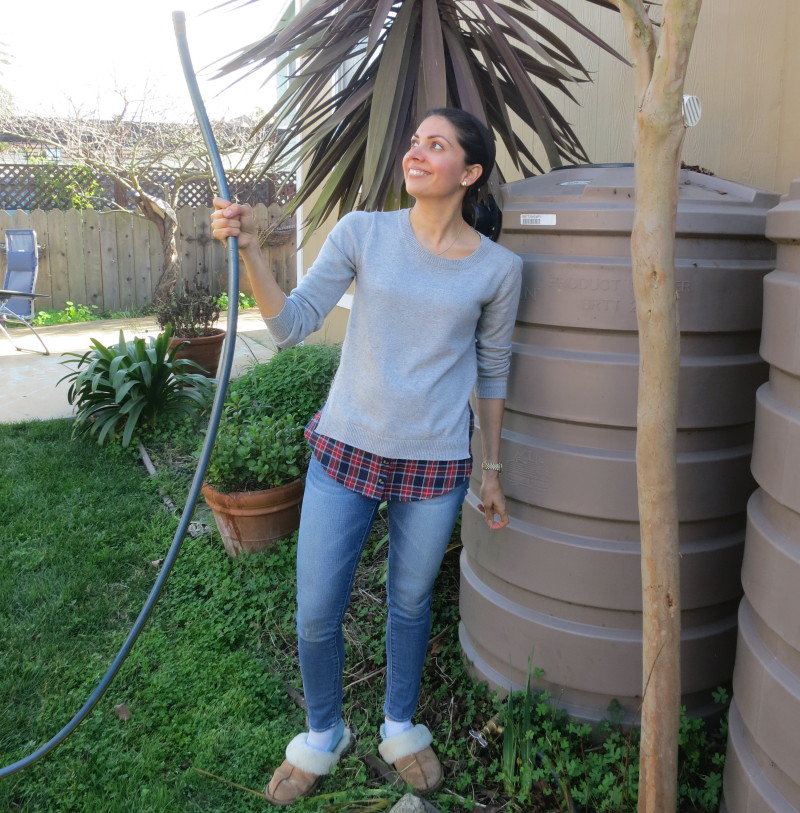How long did it take to capture 820 gallons?
“During that last big rain in December, it took less than an hour,” Nini Argeris said.
Argeris says she stretched the water she collected early last year to nourish her vegetable garden all summer long.
“Instead of going in the gutters, it’s going into the tanks, into my vegetables and feeding my family,” she said. She swears the vegetables taste better when given rainwater instead of treated city water.
One of the Argerises' new neighbors is putting in a swimming pool, and the Argerises are countering with plans to add a couple more rain barrels.
Rationalizing Rain Barrels
Rain barrels seemed a logical step up from my current conservation hacks –- including catching cold water in a bucket while waiting for hot water in the shower, then dumping the bucket into the toilet when it needs a flush.
But it's tough to make a strictly dollars-and-cents argument for rain harvesting if you’re hooked up to municipal water.
The Argerises bought 205-gallon tanks for $325 each with the whole setup costing a total of $1,500 and four hours of their labor. (There are cheaper options. For instance, Alternative Solutions in Campbell sells recycled barrels for about $100 and a DIY rain barrel starter kit for $30.
Stack that cost up against the price you're paying for tap water. That supply is really cheap -- less than a penny a gallon in many districts. So your savings for filling up a 205-gallon rain barrel don't amount to much.
But of course the argument for rain barrels, and for household water conservation, isn't about the low price we're paying -- though maybe it should be. Instead, it's about recognizing how precious and precarious our water supply really is.
After what's looking like the driest January on record for much of the state, California is headed into a fourth year of drought. One barrel might not seem like much, but as California’s population grows, and our dwindling supply needs to serve more people, it’s in everyone’s interest to relax our grip on the faucet.
All Sorts of Ways to Conserve
And that leads to a point that folks with Bay Area water districts made to me when I asked them about rain barrels: It's probably more water-wise for me and most Bay Area residents to focus on the demand side of the water equation than on the supply side.
Barrels are “a great way to capture rainwater," said Nelsy Rodriguez of the East Bay Municipal Utility District. "The trick is, it has to rain, and we don’t have a lot of control over that.”
EBMUD doesn't offer rebates for rain barrels, Rodriguez says, focusing instead on getting people to check their plumbing for leaks. The East Bay district and others throughout the region also promote other familiar tools and strategies: high-efficiency toilets, washing machines and dishwashers, and low-flow shower heads.
"I love them because other people love them," said Dan Carney of the Marin Municipal Water District of new water-saving appliances. "When they put them in, they work better so people are happy with them. They save water and money, so they are the best of all worlds. Good for people, the environment and the pocket book -- a great triple bottom line."
So, am I going to go out and buy rain barrels now?
A year ago, I made the easy water conservation fixes: low-flow plumbing, short showers and implementation of the “If it’s yellow, let it mellow” toilet-flushing rule. I also took out a lot, but not all, of the grass in the yard. Ripping out the remaining grass would save water more reliably than waiting to capture rain.
So my first move now will be to replace the remaining grass with more drought-tolerant vegetation. My neighbor, Nini Argeris, said she’d help.
When the rain does come, I’ll miss out on the thrill of the fill and neighborhood rain-barrel boasting rights. And I'm OK with that.
